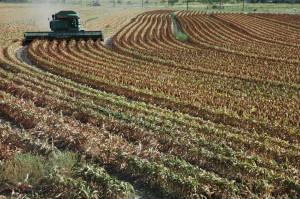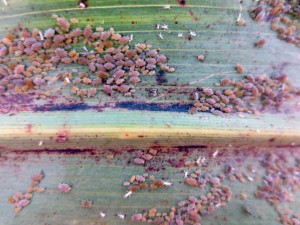By Kathleen Phillips
Sugarcane aphids have been identified on sorghum in San Saba and Coleman counties, marking the first time the insect has been found west of Interstate-35, according to Dr. Charles Allen, Texas A&M AgriLife Extension Service statewide integrated pest management coordinator, San Angelo.
AgriLife Extension agents Rick Minzenmayer of Ballinger, Neal Alexander of San Saba and Michael Palmer of Coleman have found sugarcane aphid in sorghum fields near San Saba and Coleman, Allen said.
“Finding sugarcane aphid further west does not necessarily mean that the aphid will move into the large grain sorghum producing areas in the Rolling Plains and High Plains, but growers need to be aware that sugarcane aphids have been found west of where they were seen last year,” Allen said. “Growers should keep a close watch on their grain sorghum fields as the plants begin to head.”
Left unchecked, the aphid sucks sap from plant leaves and deposits “honeydew,” a sticky waste that clogs harvesting equipment, said AgriLife Extension entomologist Dr. Raul Villanueva of Weslaco, where farmers already have battled the insect this season. It can also move into the grain head, slowing the ripening process thus reducing both quality and yield.

Harvesting grain sorghum near San Angelo, Texas (Texas A&M AgriLife Communications photo by Steve Byrns)
The tan to cream colored sugarcane aphids initially colonize on the undersides of leaves near the bottom of plants, Allen said.
“They typically move up the plant as they increase in populations. An action level that has been working well in South and East Texas is that when about 40 percent of plants infested means it’s time to spray. Plants are considered infested if they have 100 or more aphids on one of the leaves,” he explained.
Growers had difficulty controlling this aphid with labelled insecticides last year, Allen said.
Studies in Texas and Louisiana in 2013 determined that Transform insecticide could provide effective control. The Section 18 emergency label granted by the U.S. Environmental Protection Agency earlier this year for Transform allows for application rates from 0.75 to 1.5 ounces per acre.
“Good spray coverage is essential. Treatments can be made up until 14 days before harvest,” Allen said.
The U.S. Department of Agriculture-National Agricultural Statistics Service reports 3 million acres of grain sorghum in Texas — about 1.9 million acres of which are west of I-35.
This year, the Rio Grande Valley already has harvested about 400,000 acres of the crop. Most of the rest of the state’s sorghum is still maturing in the field. The East Texas crop will be harvested in a few weeks. The West Texas crop is usually harvested in late-August through early October.
The sugarcane aphid was first reported in Texas in 2013 near Beaumont in sorghum fields. It was first detected in 1977 in Florida sugarcane. Some 22 years later, it was found in Louisiana sugarcane, Villanueva said.

Populations of the sugarcane aphid are seen on the underside of grain sorghum leaves. They decrease yields and secrete a sticky waste called honeydew that gums up combine harvesters. (AgriLife Extension photo by Dr. Raul Villanueva)
Villanueva said the biology of the insect makes it a “much more serious threat. Like most aphid species, it is parthenogenetic, meaning populations are all female and don’t require a male to reproduce. When populations become overcrowded, some develop wings and fly off to other fields or plants to colonize there. They don’t lay eggs; they simply give birth to new female aphids — and very quickly. That’s one reason why populations can quickly spread and increase to critical levels.”
Source : agrilife.org